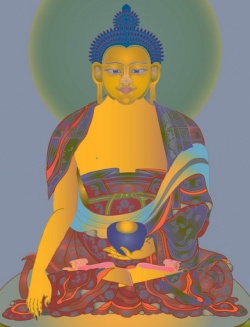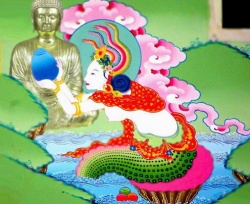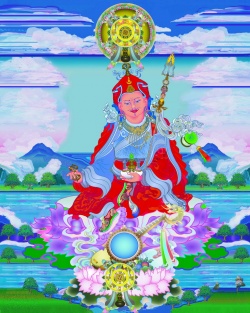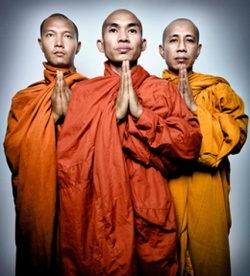The Realms Of The Guardians
Bhummanam devanam … tavatimsa deva saddamanussavesum.
When they heard what the Earth devas had said, the devas of the realm
of the Four Great Kings cried out with one voice: “At Varanasi …”
And when they heard the cry of the devas of the realm of the Four Great Kings,
then the devas of the realm of the Thirty Three cried out with one voice …
So they all start celebrating. The Earth devas start off and then the devas of the realm of the Four Great Kings join in, and then the cry goes up and up, with each celestial realm being succeeded by higher ones. In the two realms depicted here, guidance and personal responsibility are very important. The Catummaharajaka devaloka is the realm of the Four Great Kings who are the lokapalas or world guardians. In this sense, they represent the consciousness of the world rather than being comic book superheroes who wear skin tight leotards and do battle with extra terrestrial villains with names like Smarg and The Exterminator. The lokapala style of guardianship is more befitting to celestials with ethereal bodies.
In the last half of the twentieth century, people began to consider that the planet and all forms of life on it, the climate and the mixture of chemicals in the air and water, might exist in a sensitive balance that is somehow self regulating. It does not appear to be ruled by a Creator God separate from it, but to say that it is not directed would be the opposite view—the materialistic view that has led to the gross and selfish exploitation of Planet Earth and all forms of life by humankind. Nowadays, scientists are beginning to talk about a self regulating principle guarding the planet—they call it Gaia; in ancient civilizations, it was Earth Mother or Sky God or Great Spirit; in Buddhist cosmology, it is the Four Great Kings and the devata of the Thirty Three who live on the world mountain, Mount Meru.
The Buddhist emphasis is on mind and consciousness. This, for beings with consciousness, is the access point to the subtle forces that govern the world of Nature. Consciousness is a subtle, localized and highly developed aspect of creation. Within its immaterial forms are the patterns that abide in the material sphere. Consciousness is the world in which Mount Meru is a symbol for the upright, centered mind, the axis mundi—the central pole of our being. If Mount Meru is secure from corruption and upheaval, the world system is in order. If the human mind is clear and uncorrupted by delusions, hatred, pride and intoxication, then our world is balanced.
In this analysis, the uprightness of the mind implies more than is normally meant by a simple moral standard; it signifies a whole view on the world and on life, in which the ego is dethroned from being the moral arbiter and center of the Universe. In Buddhist social convention, the ideal ruler, referred to as the Wheel turning Monarch, was one who was invested with the ten righteous principles or rajadhammas. These are: generosity, virtuous conduct, self sacrifice, honesty/integrity, gentleness, self control, calmness, non violence, patient forbearance and conformity to the principles of Dhamma. These qualities are regarded as the proper rulers of the world; whether this is the “external” social world, or the microcosm of our own person. While these principles are firm, Mount Meru—the stable balance within the individual and in society—is secure. When these are decaying, the converse is true, with effects that manifest in wider contexts such as the increase in violent crime, suicide and drug abuse:
When people are consumed by improper desires, overwhelmed by corrupt ambitions, obsessed by wrong ideals, the rainfall dwindles. It is hard to get a meal. The crops are bad, afflicted with mildew and stunted. Because of this, many people perish.
(Anguttara Nikaya: [1] Threes, 6, 56; my trans.)
The Buddha saw an intimate connection between the world of consciousness and the natural world; self view in consciousness always affects the attitudes and the motivations that, in turn, affect the world at large. It doesn"t take a completely enlightened being to realize that today"s environmental problems stem from greed, and wrong values which manifest as personal wealth pursued at the expense of others.
So the devata of the Four Great Kings and the Realm of the Thirty Three are mostly connected to energies in consciousness. As such, they are frequently mentioned as seeking advice from the Buddha. Sakka (also known as Inda) is the ruler of both realms. In this painting, he is depicted being carried by a yakkha, (a kind of genie or ogre), kneeling in front of a Buddha who appears in the regalia of a Wheel turning Monarch. The Four Great Kings are immediately above. In the East is Dhatarattha. He is generally accompanied by the white devata called gandhabbas, the skilled musicians mentioned previously. When they are in charge of things, the East is a serene quarter. Virulhaka is the King of the South. He oversees this quarter with the help of some kumbhandas, reputedly gnome like beings with pot bellies and short limbs. The guardian of the North is called Vessavana or sometimes Kuvero and he is accompanied by a host of yakkhas. The West is guarded by Virupakkha who has a band of nagas to back him up. His is quite a team because nagas are giant serpents who draw upon and embody the rhythmic flowing power of water and the moon.
These are the four celestial guardians who try to defend the four corners of the world by keeping it free from demonic energies. Like Inda and the devata of the Thirty Three, they are often called upon to defend Mount Meru from the attacks of the asuras, the selfish fallen gods of conceit, pride and power. However, like all the devas, they are very much affected by the activities of the human realm. When there"s a lot of killing, stealing, lying and greed, that sets up a pretty unpleasant vibration which makes it difficult for them to function properly. Judging from conditions in the world today, these devata seem to be sorely pressed to keep the asuras and demons at bay. They have a high sense of responsibility and concern for the world, so they rejoice when Buddhas appear in the world to advise human beings how to live wisely.
The next realm above that of the Four Great Kings is the realm of the Thirty Three, Tavatimsa, which is shown in the lower half of the painting. The realm is variously described as inhabited by thirty three devata or a ruling committee of thirty three. It is, of course, fantastically beautiful and pleasant. It is a sociable world. There are frequent meetings in the Great Hall; gatherings to listen to celestial concerts, and sometimes guest deities, a visiting Arahant or the Buddha himself drop in to talk on the subject of Dhamma.
This realm is the normal abode of Inda (in Pali) or Indra (in Sanskrit), who was one of the supreme gods of the Vedas—the ancient religious texts, which pre date Buddhism. Just as the early Christians absorbed aspects of native religions by canonizing their barbaric gods, the Buddhists transformed Inda from a thunderbolt wielding sky warrior to a righteous monarch, lover of the Dhamma and disciple of the Buddha. In one of the suttas (Digha Nikaya: 21 Sakkapanha Sutta), Inda, having recognized that his time was drawing to an end, puts forth renewed spiritual zeal and attains stream entry. He takes his position as a celestial ruler quite seriously. In the Jataka stories, Inda acts as a witness to the Great Being"s practices of supreme paramita, intervening from time to time to put the Great Being to the test which will enable him to manifest his great virtues. One time, Inda appeared as a hungry Brahmin when the Great Being was a hare and asked him for some food. The hare, having no food to offer, responded by offering his own body as food and throwing himself on a fire to cook (after shaking all the fleas out of his fur). At that moment, the fire went cold and Inda proclaimed the self sacrifice of the hare, and, as a lasting testimonial, drew the hare"s face on the moon. (Remember we"re in the realm of mythic truth, here.)
These accounts define Inda as a righteous ruler of realms that are ethically sympathetic to the human realm and interested in its welfare; we should also recognize that Inda, like the realms themselves, plays a part in the human mind. “Inda” is related to the word indriya, the five spiritual faculties that govern the contemplative mind. These are faith, energy, mindfulness, concentration and wisdom. If these are not developed in a balanced way, spiritual cultivation is patchy. When “the proper ruler” is present in terms of spiritual practice, or in terms of relationships and duties in the world, the mind is upright and there is a feeling of “rightness.” There is a kind of happiness, less gleeful but more flexible and useful, that comes from being balanced and well guided within oneself. This is the well being of these celestial realms. However, one has to realize that the extent of this ruling principle is changeable. One can"t expect the world to always be under harmonious rule, or the society, or the family. Even in the Sangha, during the time of the Buddha, there was plenty of disharmony, squabbling and corruption; and much the same is true today. In my experience, monasteries go through cycles of inspiration and gloom when people get disillusioned and things become difficult.
Attachment to this realm of social order means that you worship the Buddha as the epitome of everything working out in an orderly and peaceful way. Then you suffer when it changes, and you get disillusioned with Buddhism. But the Buddha never said, “Stick with me and everything will work out well. Believe in me and you will never be disappointed by injustice in the world, or by corrupt monks or apathetic nuns; you"re on the winning team.” He said: “The conditions that support the apparent world are impermanent; keep practicing diligently.” That"s the Refuge of the Dhamma, and as you can see in this painting, attachment to perceptions of fairness, rightness and harmony weakens the impression of that Dhamma Wheel.
The beings of these two devaloka also see the Buddha in their terms, as a being of supreme, though benevolent, power. This kind of Buddha is called a Dhammaraja, the Buddha as king of the Dhamma. He appears in the human realm, too. Giving confidence to Buddhists in the centuries after the Master"s decease, such a figure was occasionally carved in stone in the Buddhist kingdoms of India.
From around the first century B.C., Buddhist iconography developed in Northern India for devotional purposes. Gradually there emerged a pantheon of Buddhist saints, Bodhisattvas and Buddhas. This stems from the human mind"s natural inclination towards the physical human form rather than towards the abstract “this is the way things are.” Kondanna"s insight that everything that arises passes away can fail to have much impact on a human mind. You could overlook that in a moment, couldn"t you? But that desire to find a guru or a leader or to be able to personify the teaching in a physical form is a very strong tendency for a human being. From this desire to personify the teaching comes the tendency to glorify this human form. In this picture, we already see the Dhamma Wheel looking vague and faint behind this powerful figure.
So over time—unless there is a community or a good, consistent teaching that keeps inclining towards Dhamma—it"s easy to miss the point and get involved with the qualities of the teacher: “I"ve got to be like that teacher, then I"ll be an enlightened being.” This again is an example of the origin of suffering rather than the cessation of it because, of course, it"s not up to any of us to be like anyone else. But if we apply ourselves to Dhamma, we can be uniquely ourselves and that is good enough; we need not invest this mundane mortal form with charisma. However, to have this kind of confidence in the way it is requires penetration of the Dhamma rather than inspiration from a teacher. The devas don"t have that understanding in Dhamma because they can"t keep track of things arising and passing away. Devas live for at least ten thousand years so they have little recollection of death. When they finally die, they do so very discreetly. Their twinkle goes out; they"re just not seen any more, and everyone says: “D"you remember what happened to … ? Who … ? Oh … peel me another grape.” They"re forgotten. It"s the same with us humans: just consider, when you"re feeling captivated, high and inspired, how much do you really remember of everything that arises passes away? You have to be fairly grounded to recognize that even the higher aspects of mind are impermanent conditions.






